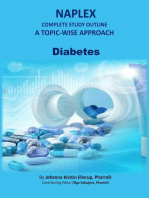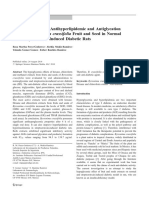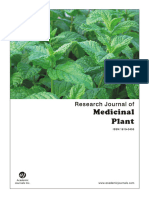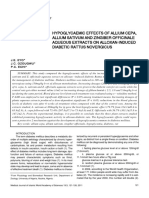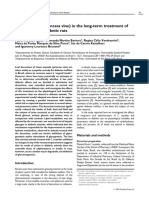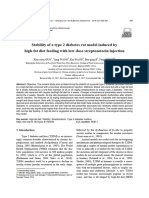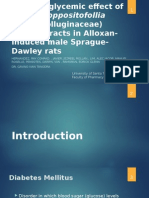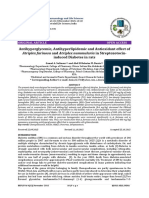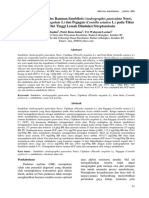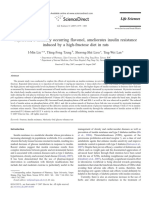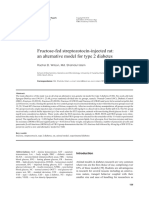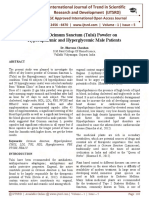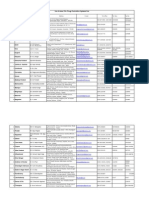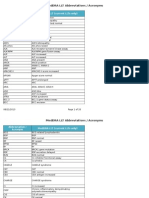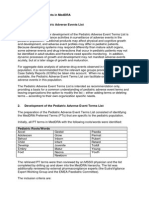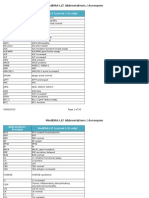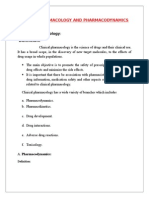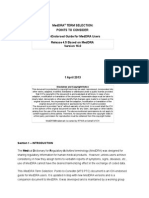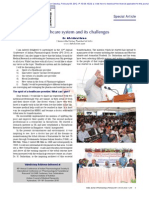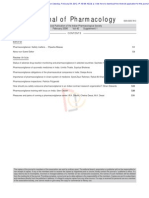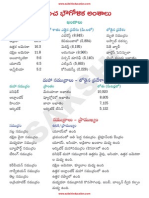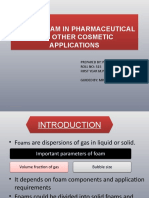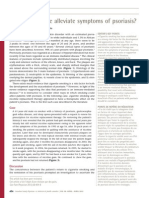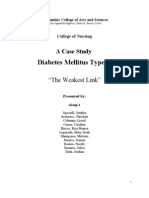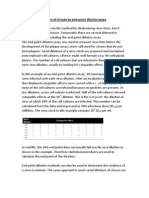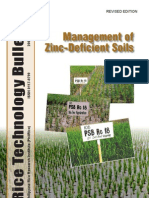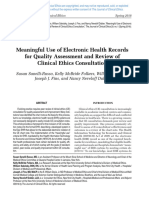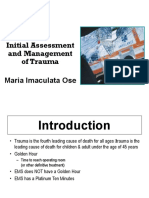Daabs-2: A Novel Ethnomedicinal Polyherbal Formulation For The Management of Diabetes Mellitus
Daabs-2: A Novel Ethnomedicinal Polyherbal Formulation For The Management of Diabetes Mellitus
Uploaded by
rr48843Copyright:
Available Formats
Daabs-2: A Novel Ethnomedicinal Polyherbal Formulation For The Management of Diabetes Mellitus
Daabs-2: A Novel Ethnomedicinal Polyherbal Formulation For The Management of Diabetes Mellitus
Uploaded by
rr48843Original Description:
Original Title
Copyright
Available Formats
Share this document
Did you find this document useful?
Is this content inappropriate?
Copyright:
Available Formats
Daabs-2: A Novel Ethnomedicinal Polyherbal Formulation For The Management of Diabetes Mellitus
Daabs-2: A Novel Ethnomedicinal Polyherbal Formulation For The Management of Diabetes Mellitus
Uploaded by
rr48843Copyright:
Available Formats
IOSR Journal of Pharmacy and Biological Sciences (IOSR-JPBS)
ISSN: 2278-3008. Volume 5, Issue 1 (Jan. Feb. 2013), PP 38-41
www.iosrjournals.org
Daabs-2r: A Novel Ethnomedicinal Polyherbal Formulation For
The Management Of Diabetes Mellitus.
Amodu B1 , Itodo S.E2
1
Halamin Herbal centre, 10 George Innih Crescent, Apo District, Abuja Nigeria
Department of Histopathology and Cytology, Jos University Teaching Hospital (JUTH) Jos Nigeria
Abstract: Being aware of the Panorama the Continuous use of ineffective pharmaceuticals whose side effects
outweigh the beneficial effects poses on diabetics, it becomes pertinent that halting these side effects associated
with these conceivably orthodox medicaments needs to be a global priority, one of such ways is to return to the
natural products.
This research was aimed at evaluating the efficacy of DAABS-2, a novel ethnomedicinal polyherbal
formulation on Insulin Depended Diabetes mellitus and non Insulin Dependent Diabetes mellitus by using
streptozotocin-induced diabetic laboratory animals and the result showed that the administration of 180mg/kg
and 100mg/kg with the corresponding DAABS-2 extracts decreased blood glucose by 90% compared to the
placebo treated diabetic animals respectively.
Keywords: Natural products, DAABS-2, Streptozotocin, Diabetics, Ethnomedicinal.
I.
Introduction
According to the International Diabetes Federation (IDF), around 194 million People suffer from
diabetes all over the world. Therefore, it has been classified as a serious problem to public health for it is the
fourth or fifth cause of death in developed countries and an epidemic for developing ones.
Being aware of this Panorama, some researches have been carried out to obtain useful drugs to treat Diabetes,
including plants.
Some curative plants are used empirically as hypoglycemics, such as Dioscorea alata L, Vernonia
amygdalina and zingibir officinale. These are the constituents of DAABS 2
The medicinal uses of the constituents of DAABS 2R are well documented in literature (Dalziel 1937).
Continued use of ineffective pharmaceuticals whose side effects outweigh the beneficial effects not only
contributes to the debilitating state of diabetes but also causes a deafening increase in diabetes-related morbidity
and mortality.
Complementary and alternative (herbal) preparations could prevent a substantial percentage of the deaths each
year from diabetes.
Halting these side effects associated with these conceivably orthodox medicaments needs to be a global
priority, and resources must be focused on those areas of the world where the burden from the disease is
greatest. One of such ways is to return to naturaceuticals, variously tagged; herbal medicines, natural products,
complementary and alternative medicine (CAM) or even traditional medicines
The use of herbal medicine dates back to thousands of years. Although it originated in India and China,
it is widely practiced in Africa. Herbal therapy which started as folk medicine in most developed countries is
becoming increasingly more popular with patients seeking alternative treatment options
Eisenberg et al., (1998) reported that, in developed countries the number of visits to the alternative medicine
practioners is growing rapidly with the number of visits in US was estimated to be 629 million in 1997; it was
believed to have exceeded the number of visits to all primary care physicians.
It is a known fact that, a large proportion of African population uses some form of alternative medicine
and many do not inform their physician about it.
Most patients seek alternative medicine because of lack of basic health facilities, when conventional
therapy has failed or they feel the products have no side effects because they are of natural origin
Herbal therapy has also been used extensively in Nigeria. Although more than 80 percent of the people in both
the underdeveloped and the developed countries depend on herbal medicines for their medical needs
The major problems with herbal medicines in such countries still remains their poor and sometimes unhealthy
presentation.
The most common animal model of human diabetes is streptozotocin(STZ)-induced diabetes in the rat.
This study therefore was carried out to evaluate and provide information on the efficacy of DAAB-2R. Data
generated will form part of the preclinical dossier required by the World Health Organization (WHO) and the
Nigerias food and drug regulatory body, the National Agency for Food and Drug Administration and Control
www.iosrjournals.org
38 | Page
Daabs-2r: A Novel Ethnomedicinal Polyherbal Formulation For The Management Of Diabetes
(NAFDAC) in phytomedicines development. The information may also be useful in the development of
Nigerias herbal pharmacopoeia.
II.
Materials And Methods
Experimental Animals
Laboratory bred Swiss albino mice of either sex, 6-8 weeks of age, weighing 25-30 g were Obtained from the
National Veterinary Research Institute Vom, plateau state.
The mice were kept in the animal house of the Ben Amodu farm and research centre, Abuja. The
animals were allowed to acclimatize to the environment for 2 weeks before the experiment. They were fed with
commercial feeds pellet and clean water ad-libitum. The cages were cleaned daily. The animals were housed in
a polypropylene cages inside a well ventilated room. Each cage contained not more than 3 rats. They were
maintained under standard laboratory conditions of temperature 24-280C, relative humidity 60-70% and 12
hours light/dark cycle.
Induction Of Diabetes Mellitus
Streptozotocin was obtained from Sigma Chemicals Co., St. Louis, MO, USA.STZ was dissolved in
cold 0.01 M citrate buffer, pH 4.5 and always prepared freshly for immediate use within 5 min. STZ injections
were given intraperitoneally and the doses were determined according to the body weight of animals. The blood
glucose concentration was measured every week from the day of STZ injection. The blood samples were
collected from the tail vein once a week and the blood was deproteinized. The obtained supernatant was used
immediately for the determination of blood glucose by glucose Oxidase/peroxidase method
spectrophotometrically
Experimental Groups And Protocol
The animals were distributed in to five experimental groups. Each group consisted of 8 rats in the
beginning of the study. Animals in group I were intraperitoneally administered single injection of 180 mg/kg of
STZ with 50mg/kg of the DAABS 2 extracts. Animals of group II were intraperitoneally administered a single
injection of 100 mg/kg of STZ with 50mg/kg of the DAABS 2 extracts. Animals of group III were
intraperitoneally administered 180mg/kg of STZ with 50mg/kg of placebo. Animals of group IV were
intraperitoneally administered a single injection of 100mg/kg of STZ with 50mg/kg of placebo. Animals of
group V served as control group were injected with equivalent amount of cold citrate buffer (pH 4.5). All the
doses of STZ were administered at a volume not exceeding 1ml/100 g body weight of mice.
Statistical Analysis
The data were expressed as mean. To obtain comparable results, data of six rats from each group was
used for statistical analysis.
III.
Results
The values of blood glucose concentrations are presented in Table 1&2. All the animals were weighed
weekly and their general conditions were also monitored throughout the experimental duration
Effect Of Single Stz Injection (180 Mg/Kg, I.P.) On Blood Glucose
All the animals develop diabetes mellitus within a week after administration of 180 mg/kg STZ. A
significant rise in blood glucose concentration was observed till 3rd week in comparison with control. By the
completion of 5th week >20% mortality was observed (2 out of 8 animals died) because of which we have
included only the data of six rats survived till the end of the study.
Effect Of Single Stz Injection (100 Mg/Kg, I.P.) On Blood Glucose
None of the animal develops diabetes with STZ 100 mg/kg. Though a insignificant increase in blood
glucose concentration was observed at the 2nd and 3rd week after STZ injection. But the blood glucose
concentrations were far below the threshold value for the animals to be considered as diabetic. No mortality was
observed in this group.
www.iosrjournals.org
39 | Page
Daabs-2r: A Novel Ethnomedicinal Polyherbal Formulation For The Management Of Diabetes
Table 1: Blood glucose levels with streptozotocin-induced type 1&2 Diabetes and the extracts in
mice
Time period
STZ 180(n=6)
Blood Glucose Mmol/L
0 day
7.7
Week 1
7.9
Week 2
8.0
Week 3
7.9
Week 4
6.9
Week 5
6.2
P 0.05
STZ 100(n=6)
6.2
6.9
7.0
6.2
5.2
5.0
Control (distilled water)
5.0
5.2
5.2
4.8
4.9
5.0
Table 2: Blood Glucose levels with streptozotocin-induced type 1&2 Diabetes with the
placebo in mice.
Time period
STZ 180 (n=6)
STZ 100(n=6)
Control (distilled water)
Blood Glucose Mmol/L
0 day
28.00
8.00
5.00
Week1
29.95
8.90
5.20
Week 2
34.32
9.98
4.80
Week 3
34.01
9.11
4.90
Week 4
33.46
8.00
5.00
Week 5
34.00
7.72
5.10
P 0.05
IV.
Discussion
Streptozotocin induced diabetes is a well documented model of experimental diabetes. Previous
reported literature indicates that the type of diabetes and characteristics differ with the employed dose of STZ
and animal and species used [4-7]. Streptozotocin induced diabetes provides a relevant example of endogenous
chronic oxidative stress due to the resulting hyperglycemia [16]. STZ is a pancreatic cell toxin that induces
rapid and irreversible necrosis of cells [6]. Whereas a single diabetogenic dose of STZ (70-250mg/kg, body
weight) has been demonstrated to induce complete destruction of cells in most species within24 hour, multiple
sub-diabetogenic doses of STZ partially damage islets, thereby triggering an inflammatory process leading to
macrophage and subsequent lymphocyte infiltration, which is followed by the onset of insulin
deficiency[17,11].
In the present study, we studied the effects of DAABS extracts on streptozotocin-induced diabetes in
mice using two models, one specific for type 1 by administering a single I.P injection of STZ 180mg/kg with
50mg/kg of the extracts, another specific for type II by administering a single I.P injection of STZ 100mg/kg
with 50mg/kg of the extracts.
The table two that was served with placebo showed marked and steady rise in the blood sugar level of
the mice.
Present study results demonstrate that a single i.p injection of STZ 180mg/kg produced diabetes
mellitus in the very first week and the animals remained in that state till 3 rd week similar to the previous study
report in which mice administered 200mg/kg STZ induced a sharp rise with an accompanying marked fall in
serum insulin levels from the first day after STZ administration in mice and produced type 1 or insulin
dependent diabetes mellitus (12). In another development, a single i.p. injection of STZ 180mg/kg with the
DAABS-2 extracts produced no sign of diabetes mellitus at any moment, and it continued throughout the course
of the experiments. This lends credence to the fact that the extracts did indeed halted diabetes mellitus with no
side effects.
Furthermore, this study also reported that mice administered 100mg/kg STZ, non fasting serum glucose
level continued to increase gradually after STZ administration without affecting the non-fasting serum insulindependent diabetes. However, STZ 100mg/kg administered mice failed to produce diabetes mellitus in our
study; this is probably due to the incorporation of the extracts in the mice feeds.
In another development, where the placebo was used, STZ 100mg/kg only produced hyperglycemia in
the 2nd and 3rd week and the blood glucose begin to decline after the 4 th and 5th week and the values were far
below the threshold value (13.89Mmol/L) for the animals to be considered as diabetic. Although this findings
www.iosrjournals.org
40 | Page
Daabs-2r: A Novel Ethnomedicinal Polyherbal Formulation For The Management Of Diabetes
are not in agreement with previous other reports (13,14) where STZ 100mg/kg has been reported to produce
type II or non-insulin dependent diabetes mellitus and blood glucose concentrations remained high till 9 th week.
Our study however assessed the blood glucose level till 5th week only because it was observed that blood
glucose concentration was abating in 5th week.
In summary, the present study results indicate that single i.p. injection of STZ 180mg/kg and 100mg/kg
with the correspondent extracts produced no diabetes of any form, while the same i.p injection of 180mg/kg and
100mg/kg with the corresponding placebo produced type 1 or insulin dependent diabetes, however, the latter
failed to produce diabetes mellitus. The severity and mortality of diabetes with STZ 180mg/kg is more in
comparison to 100mg/kg. The long-term complications of diabetes mellitus and the characteristics of
progressive diabetes mellitus in the group with the placebo could be studied.
References
[1]
[2]
[3]
[4]
[5]
[6]
[7]
[8]
[9]
[10]
[11]
[12]
[13]
[14]
[15]
[16]
[17]
[18]
[19]
Akbarzadeh A, Norouzian D, Mehrabi MR, Jamshidi S, Farhangi A, Allah A, Mofidian S, Lame Rad B (2007) Induction of diabetes
by streptozotocin in rats. IJCB 22: 60-64.
Brosky G, Logothetopoulos J (1969) Streptozotocin diabetes in the mouse and guinea pig. Diabetes 8: 606-611.
Elias D, Prigozin H, Polak N, Rapoport M, Lohse A W, Cohen I R (1994) Autoimmune diabetes induced by the b-Cell toxin STZ.
Diabetes 43: 992-8.
Gbel H, Bitter-Suermann H, Henriksson C, Sve-Sderbergh J, Lundholm K, Brynger H (1985) Streptozotocin diabetes in juvenile
pigs. Evaluation of an experimental model. Horm Metab Res 17:275-280.
Ganda OP, Rossi AA, Like AA (1976) Studies on streptozotocin diabetes. Diabetes 25: 595- 603.
Hayashi K, Kojima R, Ito M (2006) Strain differences in the diabetogenic activity of streptozotocin in mice. Biol Pharmaceut Bull
29: 1110-1119.
Higdon H L, Parnell PG, Hill J E Spitzer JC (2001) Streptozocin-induced pancreatic islet destruction in beef cows. Vet Pathol
38:715-720.
Holemans K, Bree R.V, Verhaeghe J, Meurrens K, Assche A V (1997)n Maternal semi starvation and Streptozotocin-diabetes in rats
have different effects on the in vivo glucose uptake by peripheral tissues in their female adult offspring. J Nutr 127:1371-6.
Ikebukuro K, Adachi Y, Yamada Y, Fujimoto S, Seino Y, Oyaizu H (2002) Treatment of Streptozotocin-induced diabetes mellitus by
transplantation of islet cells Plus bone Marrow cells via portal vein in rats. Transplantation 73: 512-518.
Ito M (1999) New model of progressive non-insulin-dependent diabetes mellitus in mice induced by Streptozotocin. Biol Pharmaceut
Bull 22: 988-989.
Junod A, Lambert AE, Stauffacher W, Renold AE (1969) Diabetogenic action of streptozotocin: relationship of dose to metabolic
response. J Clin Invest 48:2129,
Kaneko JJ, Rhode EA (1964) Diabetes mellitus in a cow. J Am Vet Med Assoc 144:367-373.
Kitchen DL, Roussel AJ Jr (1990) Type-I diabetes mellitus in a bull. J Am Vet Med Assoc 197:761-763.
Rastellini C, Shapiro R, Corry R, Fung J J, Starzl T E, Rao A S (1997) An attempt to reverse diabetes by delayed islet cell
transplantation in Humans. Transplantation 29: 2238-2239.
Smith SB, Prior RL, Mersmann HJ (1983) Interrelationship between insulin and lipid metabolism in normal and alloxan-diabetic
cattle. J Nutr 113:1002-1015.
Stangassinger M, Peruche T, Giesecke D (1982) Diabetes mellitus in dwarf goats: model experiments with streptozotocin. Zentralbl
Vet Med 29:297-304.
Szkudelski T (2001) The mechanism of alloxan and streptozotocin action in B cells of the rat pancreas. Physiol Res 50:537-46.
Takeshita F, Kodama M, Yamamoto H, Ikarashi Y, Ueda S, Teratani T, Yamamoto Y, Tamatani T, Kanegasaki S, Ochiya T, Quinn
G (2006) Streptozotocin-induced partial beta cell depletion in nude mice without hyperglycaemia induces pancreatic morphogenesis
in transplanted embryonic stem cells. Diabetologia 49:2948-58.
Weiss RB (1982) Streptozotocin: A review of its pharmacology, efficacy and toxicity. Canc Treat Rep 66: 427-438.
www.iosrjournals.org
41 | Page
You might also like
- Magic DustDocument29 pagesMagic DustKeyur ShahNo ratings yet
- FrequenciesDocument7 pagesFrequencieszerotalenNo ratings yet
- Naplex Complete Study Outline A Topic-Wise Approach DiabetesFrom EverandNaplex Complete Study Outline A Topic-Wise Approach DiabetesRating: 4 out of 5 stars4/5 (3)
- Aspergers Syndrome Through The LifespanDocument8 pagesAspergers Syndrome Through The Lifespanadrian zach benjaminNo ratings yet
- Perez Gutierrez2010Document8 pagesPerez Gutierrez2010Guilherme VarellaNo ratings yet
- The EffectDocument6 pagesThe EffectDavid IsuNo ratings yet
- Farmakologi Benincasa Hispida (Kundur)Document11 pagesFarmakologi Benincasa Hispida (Kundur)Syahrir ManaanNo ratings yet
- Chavez Et Al - Final PaperDocument9 pagesChavez Et Al - Final PaperJed BellenNo ratings yet
- Diabetes & Metabolism: Hypoglycemic Effect of Kyllinga Triceps in STZ Induced Diabetic RatsDocument3 pagesDiabetes & Metabolism: Hypoglycemic Effect of Kyllinga Triceps in STZ Induced Diabetic RatsSujith KuttanNo ratings yet
- In Vivo Antidiabetic Potential and Safety of Aqueous ExtractDocument8 pagesIn Vivo Antidiabetic Potential and Safety of Aqueous ExtractTJPRC PublicationsNo ratings yet
- Randomized Controlled Trial of Tinospora Crispa For Additional Therapy in Patients With Type 2 Diabetes MellitusDocument4 pagesRandomized Controlled Trial of Tinospora Crispa For Additional Therapy in Patients With Type 2 Diabetes MellitusEva SuryantiNo ratings yet
- Morinda Citrifolia: Research ArticleDocument5 pagesMorinda Citrifolia: Research ArticleMayara MeloNo ratings yet
- rat fat (3)2Document8 pagesrat fat (3)2drloparayiatulNo ratings yet
- Research Journal of Pharmaceutical, Biological and Chemical SciencesDocument12 pagesResearch Journal of Pharmaceutical, Biological and Chemical Sciencesrr48843No ratings yet
- Induction of Diabetes by Streptozotocin in RatsDocument5 pagesInduction of Diabetes by Streptozotocin in RatsJusty GuavaNo ratings yet
- Herbs Against DiabtiesDocument10 pagesHerbs Against DiabtiesSobia NoreenNo ratings yet
- Research ArticleDocument9 pagesResearch ArticleSabatin ArnaldoNo ratings yet
- Jurnal Fartoks KunyitDocument11 pagesJurnal Fartoks Kunyitrambutan0408No ratings yet
- Efficacy of Aqueous Leaf Extract of Vernonia Amygdalina On Plasma Lipoprotein and Oxidative Status in Diabetic Rat Models. H. U. NwanjoDocument4 pagesEfficacy of Aqueous Leaf Extract of Vernonia Amygdalina On Plasma Lipoprotein and Oxidative Status in Diabetic Rat Models. H. U. NwanjoNgan HoangNo ratings yet
- International Journal of Research in Biological Sciences: ISSN 2249 - 9687 Original ArticleDocument5 pagesInternational Journal of Research in Biological Sciences: ISSN 2249 - 9687 Original ArticleKannadhasan DassNo ratings yet
- Physiology and Endocrinology: J.E. Eyo J.C. Ozougwu P.C. EchiDocument6 pagesPhysiology and Endocrinology: J.E. Eyo J.C. Ozougwu P.C. EchiErika Putri JayantiniNo ratings yet
- Study of Antidiabetic Activity of Alli Chooranam (Nymphaea Nouchali) Burm.f)Document7 pagesStudy of Antidiabetic Activity of Alli Chooranam (Nymphaea Nouchali) Burm.f)IJAR JOURNALNo ratings yet
- Indian Medicinal Plants in DiabetesDocument6 pagesIndian Medicinal Plants in DiabetesDr Dushyant Kamal DhariNo ratings yet
- Ijsid: International Journal of Science Innovations and DiscoveriesDocument9 pagesIjsid: International Journal of Science Innovations and DiscoveriesijsidonlineinfoNo ratings yet
- 14 PDFDocument8 pages14 PDFWahyudi CasperNo ratings yet
- Antidiabetic and Antihyperlipidemic Effect of Alstonia Scholaris Linn Bark in Streptozotocin Induced Diabetic RatsDocument7 pagesAntidiabetic and Antihyperlipidemic Effect of Alstonia Scholaris Linn Bark in Streptozotocin Induced Diabetic RatsShaik ShoaibNo ratings yet
- Aktifitas Antidiabetik Dan Antioksidan Extract Etanol 70% Daun Sirih Merah (Piper Crocatum) Pada Tikus Wistar Model Diabetes MellitusDocument4 pagesAktifitas Antidiabetik Dan Antioksidan Extract Etanol 70% Daun Sirih Merah (Piper Crocatum) Pada Tikus Wistar Model Diabetes MellitusholipahfkubNo ratings yet
- Antidiabetic Effects of Catharanthus Roseus, Azadirachta Indica, AlliumDocument4 pagesAntidiabetic Effects of Catharanthus Roseus, Azadirachta Indica, Alliumshahbaz zafarNo ratings yet
- Biotech and App Biochem - 2010 - Pepato - Cissus sicyoides princess vine in the long‐term treatment ofDocument6 pagesBiotech and App Biochem - 2010 - Pepato - Cissus sicyoides princess vine in the long‐term treatment ofTiago RodriguesNo ratings yet
- Antidiabetic Property of KlorostrepDocument9 pagesAntidiabetic Property of KlorostrepAlma BolanteNo ratings yet
- Hypoglicemic EffectDocument7 pagesHypoglicemic EffectErizal Dwi HandokoNo ratings yet
- In Vivo Nigella Sativa: Research ArticleDocument9 pagesIn Vivo Nigella Sativa: Research ArticleMena MeroNo ratings yet
- HAYVANDocument11 pagesHAYVANUgur DAĞDELENNo ratings yet
- Annaardium (2016) PDFDocument7 pagesAnnaardium (2016) PDFPutri Mustika PratiwiNo ratings yet
- Main DocumantDocument14 pagesMain Documanthddcpf2cq4No ratings yet
- Antidiabetic Effect of Syzygium Cumini L. Seed On Type 2 Diabetic RatsDocument8 pagesAntidiabetic Effect of Syzygium Cumini L. Seed On Type 2 Diabetic RatsLavanya Priya Sathyan100% (1)
- Vol3 Issue1 08 2Document5 pagesVol3 Issue1 08 2David IsuNo ratings yet
- EffectDocument8 pagesEffectMuhammad Hafiz SetiawanNo ratings yet
- Thesis Proposal.Document27 pagesThesis Proposal.Edrick RamoranNo ratings yet
- 2 FinalDocument9 pages2 FinalmellalNo ratings yet
- Nejmoa 2107519Document13 pagesNejmoa 2107519GABRIELA ZAPATANo ratings yet
- Antidiabetic Effect of Fermented (Millet) Supplement in Alloxan Induced Hyperglycemic Wistar RatsDocument4 pagesAntidiabetic Effect of Fermented (Millet) Supplement in Alloxan Induced Hyperglycemic Wistar Ratsmaster apotNo ratings yet
- Anti DiabeticDocument12 pagesAnti DiabeticanneNo ratings yet
- Untitled 1Document17 pagesUntitled 1bennyNo ratings yet
- 2583-Article Text-18181-1-10-20191218Document8 pages2583-Article Text-18181-1-10-20191218Romario AbdullahNo ratings yet
- 14 PDFDocument5 pages14 PDFBuyun'k RioehNo ratings yet
- Mercetina DiabetesDocument10 pagesMercetina DiabetesEnshi PanicNo ratings yet
- Fructose-Fed Streptozotocin-Injected Rat: An Alternative Model For Type 2 DiabetesDocument11 pagesFructose-Fed Streptozotocin-Injected Rat: An Alternative Model For Type 2 Diabetesregis.farias95No ratings yet
- 2003effect of CocciniaDocument10 pages2003effect of CocciniaamhproductsinNo ratings yet
- Evaluation of Anti-Diabetic Potentials of Albiza Zygia (DC) Stem Barks in Alloxan-Induced Diabetic RatsDocument8 pagesEvaluation of Anti-Diabetic Potentials of Albiza Zygia (DC) Stem Barks in Alloxan-Induced Diabetic RatsOnyekachi OnyekwereNo ratings yet
- Comparative Studies On Antidiabetic Effect With Phytochemical Screening of Azadirachta Indicia and Andrographis PaniculataDocument7 pagesComparative Studies On Antidiabetic Effect With Phytochemical Screening of Azadirachta Indicia and Andrographis PaniculataFaridul IslamNo ratings yet
- Lecture 24Document7 pagesLecture 24LeTienDungNo ratings yet
- Anti Diabetic HerbsDocument25 pagesAnti Diabetic HerbsSmritaPradhan PNo ratings yet
- Antidiabetic Activity of Partitionates of Aegle Marmelos Linn. (Rutaceae) Leaves Ethanolic Extracts in Normal and Alloxan Induced Diabetic RatsDocument7 pagesAntidiabetic Activity of Partitionates of Aegle Marmelos Linn. (Rutaceae) Leaves Ethanolic Extracts in Normal and Alloxan Induced Diabetic RatsIOSR Journal of PharmacyNo ratings yet
- Antidiabetic and Long-Term Effects of Elaeocarpus GrandiflorusDocument12 pagesAntidiabetic and Long-Term Effects of Elaeocarpus GrandiflorusAgus FakhrudinNo ratings yet
- 101120060206Document12 pages101120060206Febriana Nur AnggraeniNo ratings yet
- Ginger PublishedDocument8 pagesGinger PublishedFatimoh AbdulsalamNo ratings yet
- Rajendiran 2018Document4 pagesRajendiran 2018PriawanIndraNo ratings yet
- Anti-Diabetic Activity of Polyphyto Mixture in Diabetic Rats Induced by AlloxanDocument6 pagesAnti-Diabetic Activity of Polyphyto Mixture in Diabetic Rats Induced by AlloxanEarthjournal PublisherNo ratings yet
- Effect of Ocimum Sanctum (Tulsi) Powder On Hyperlipidemic and Hyperglycemic Male PatientsDocument7 pagesEffect of Ocimum Sanctum (Tulsi) Powder On Hyperlipidemic and Hyperglycemic Male PatientsEditor IJTSRDNo ratings yet
- In Vivo Sorbus Decora: Original ArticleDocument8 pagesIn Vivo Sorbus Decora: Original ArticleSophea Ananoria MissionaNo ratings yet
- 1updated List of Drug ControllerDocument2 pages1updated List of Drug Controllerrr48843100% (1)
- Meddra LLT Abbreviations / AcronymsDocument20 pagesMeddra LLT Abbreviations / Acronymsrr48843No ratings yet
- Pediatric Term List 16-1Document12 pagesPediatric Term List 16-1rr48843No ratings yet
- Paediatric Adverse Events Explanatory Note-FinalDocument2 pagesPaediatric Adverse Events Explanatory Note-Finalrr48843No ratings yet
- Meddra LLT Abbreviations / AcronymsDocument20 pagesMeddra LLT Abbreviations / Acronymsrr48843No ratings yet
- Eu, Us and Indian Patent SystemDocument12 pagesEu, Us and Indian Patent Systemrr48843No ratings yet
- Clinical Pharmacology and PharmacodynamicsDocument23 pagesClinical Pharmacology and Pharmacodynamicsrr48843No ratings yet
- Challenges in Pharmacovigilance: EditorialDocument1 pageChallenges in Pharmacovigilance: Editorialrr48843No ratings yet
- Med DRADocument3 pagesMed DRArr48843No ratings yet
- Companies TaglinesDocument7 pagesCompanies Taglinesrr48843No ratings yet
- IndianJPharmacol4313-2929898 004849Document3 pagesIndianJPharmacol4313-2929898 004849rr48843No ratings yet
- IndianJPharmacol40728-3361566 005601Document4 pagesIndianJPharmacol40728-3361566 005601rr48843No ratings yet
- IndianJPharmacol40137-144257 040025Document5 pagesIndianJPharmacol40137-144257 040025rr48843No ratings yet
- B ( Ýl (Ç Ólôœæ Ð) L$ ( Ð) Læý Y : SakshiDocument2 pagesB ( Ýl (Ç Ólôœæ Ð) L$ ( Ð) Læý Y : Sakshirr48843No ratings yet
- ™ðlë V ×Æ (Ç ¿ Æ$™Èló & Ð) L$ ( Ð) Læý Y : SakshiDocument2 pages™ðlë V ×Æ (Ç ¿ Æ$™Èló & Ð) L$ ( Ð) Læý Y : Sakshirr48843No ratings yet
- Tox Exposure GuidelinesDocument28 pagesTox Exposure Guidelinesrr48843No ratings yet
- Figure 2 Correlation Between Serum Calcitonin Levels and Disease ProgressionDocument1 pageFigure 2 Correlation Between Serum Calcitonin Levels and Disease Progressionrr48843No ratings yet
- Adverse Drug Reactions in A ComplementaryDocument8 pagesAdverse Drug Reactions in A Complementaryrr48843No ratings yet
- (Ç Ç Èl ¿Ovøãmýs A Ô Ë$: SakshiDocument5 pages(Ç Ç Èl ¿Ovøãmýs A Ô Ë$: Sakshirr48843No ratings yet
- Ð) L Qåoððl$ ) L ™Ól©Ë$, Ø™Èlþðéë$: SakshiDocument11 pagesÐ) L Qåoððl$ ) L ™Ól©Ë$, Ø™Èlþðéë$: Sakshirr48843No ratings yet
- Pe11 MidtermDocument2 pagesPe11 MidtermJoanne Manlangit Lañojan50% (2)
- 1 - Patogenesis HemorroidDocument16 pages1 - Patogenesis HemorroidYuli Setio Budi Prabowo100% (1)
- Use of Foam in Pharmaceutical and Cosmetic ApplicationsDocument22 pagesUse of Foam in Pharmaceutical and Cosmetic ApplicationsNeeraj PawarNo ratings yet
- Infectious Anaerobic Enterotoxemia Disease of SheepDocument7 pagesInfectious Anaerobic Enterotoxemia Disease of SheepCentral Asian StudiesNo ratings yet
- Early To Middle Childhood: Physical DevelopmentDocument34 pagesEarly To Middle Childhood: Physical Developmentmisz symaNo ratings yet
- Studiu de CazStudiu de Caz PDFDocument4 pagesStudiu de CazStudiu de Caz PDFCiprian BojanNo ratings yet
- October 2016 (IAL) MS - Unit 1 Edexcel BiologyDocument20 pagesOctober 2016 (IAL) MS - Unit 1 Edexcel BiologyEricka AlvarezNo ratings yet
- Cheatsheet PDFDocument2 pagesCheatsheet PDFJudaeo SandovalNo ratings yet
- CAPE Biology 2003 U2 P1Document21 pagesCAPE Biology 2003 U2 P1Sheniqua GreavesNo ratings yet
- Experiment 11 - Non Protein Nitrogen PDFDocument26 pagesExperiment 11 - Non Protein Nitrogen PDFAALIYAH REIGN MAPUSAONo ratings yet
- Acute StressDocument4 pagesAcute StressRafael MadureiraNo ratings yet
- Psychosomatic DisordersDocument11 pagesPsychosomatic DisordersJasmin Jacob100% (3)
- Diabetes Mellitus Case StudyDocument31 pagesDiabetes Mellitus Case StudyCris Tan100% (2)
- Raman and CancerDocument10 pagesRaman and CancerNasir MahmoodNo ratings yet
- Hypertension A Case-Based Approach 2020Document399 pagesHypertension A Case-Based Approach 2020tiwari gopalNo ratings yet
- SOP Vibrio CholeraDocument32 pagesSOP Vibrio Cholera'aoe'Lia Rahmawati100% (1)
- Tcid 50Document10 pagesTcid 50Rohan Walking Tall100% (1)
- ORTODONCIADocument10 pagesORTODONCIAOrlando RodríguezNo ratings yet
- 566-Article Text-2161-3-10-20210707Document6 pages566-Article Text-2161-3-10-20210707Prashant KoiralaNo ratings yet
- Textbook Reading OADocument31 pagesTextbook Reading OAFadiah GazzaniNo ratings yet
- No. 64 Management of Zinc-Deficient SoilsDocument20 pagesNo. 64 Management of Zinc-Deficient SoilsmtmustapaNo ratings yet
- Meaningful Use of Electronic Health Recordsfor Quality Assessment and Review Ofclinical Ethics ConsultationDocument10 pagesMeaningful Use of Electronic Health Recordsfor Quality Assessment and Review Ofclinical Ethics ConsultationJENIFER KARINA PUTZ LORENZINo ratings yet
- Advanced Physiology and Pathophysiology Essentials... - (Chapter 11 Lungs)Document38 pagesAdvanced Physiology and Pathophysiology Essentials... - (Chapter 11 Lungs)Ann MariletteNo ratings yet
- Local Anesthetics For The NephrologistDocument8 pagesLocal Anesthetics For The NephrologistcarolinaNo ratings yet
- Neonatal Nursing Practice Standards FinalDocument25 pagesNeonatal Nursing Practice Standards Finalb4rgbjwzhcNo ratings yet
- Basic Trauma Life SupportDocument40 pagesBasic Trauma Life Supportyunita murfhiNo ratings yet
- 30-Day Paleo ChallengeDocument23 pages30-Day Paleo Challengeteam_mo100% (1)
- Patent Literature On Mosquito Repellent Inventions Which Contain Plant Essential Oils - A ReviewDocument20 pagesPatent Literature On Mosquito Repellent Inventions Which Contain Plant Essential Oils - A ReviewFlint Zaki FloresNo ratings yet


